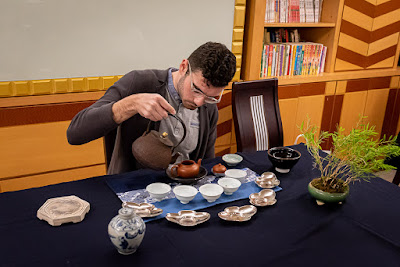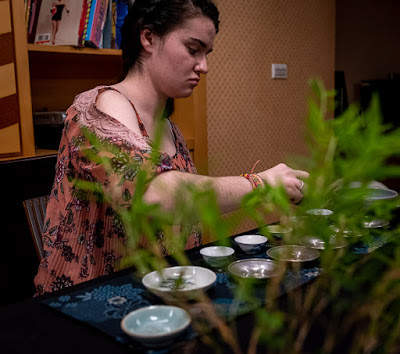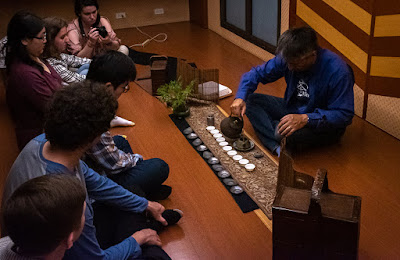Happy New Year 2020! I apologize for the long pause on the blog, but I was quite busy with 9 tea students from the Penn State Gongfucha club who came to Taiwan for a 10 days trip. We had several very interesting classes and now that they are back in the US, I wish to share several accounts of the tea activities I organized for them.
Let's start with this Chaxi lesson with a Taiwan Oolong focus. The task for every student was the same. Choose a tea from this list: 2017 spring Tsui Luan High Mountain Oolong, 2019 spring semi-wild Wenshan Baozhong, 2018 Summer imperial Oriental Beauty from Hsin Chu, 2019 fall Zhuo Yan Oolong from Shan Lin Xi, 2016 spring Hung Shui Oolong from Alishan and the 2019 spring high infrared roasted Hung Shui Oolong from Alishan.
The students could choose from a large range of teaware and new Chabu from my selection and collection to set up their Chaxi. At first, the combinations seem endless and the task daunting. But if you start with the tea then the choice of the teaware follows quite easily: you choose the teaware that will harmonize with the character of the tea. Phil (above) led the way with the high mountain Oolong. The celadon singing cups underline the freshness of the color and the blue Chabu brings us closer to the high mountain sky!
Tom chose the imperial OB. He could have chosen a Chabu with warm colors to match the color of the brew, but instead he chose this blue flowers and birds Chabu. I had no objection to this. The choice of the Chabu is very personal and there are many ways to express your teas creatively. Here, this creates a very refined contrast with the brew. And it matches the silver (which I recommended for this tea).
The silver teapot emphasizes the finesse and lightness of the fragrance of the OB, rather than the taste. So it does make sense to give the Chaxi a lighter touch!
Notice that the tea is poured in the cup first and then placed on the Chatuo. This way, there are no tea drops on the Chatuo!
Teddy chose the Semi-wild Wenshan Baozhong. This lightly oxidized Qingxin Oolong has a similar color as high mountain Oolong and therefore celadon cups are the best choice.
I also like to use a green Chabu for this tea, because the Wenshan area is covered with subtropical forest that remain green all year long!
Matt chose the Hung Shui Oolong and a porcelain teapot. This may seem like a unusual choice when there were several Yixing zisha at hand. But Matt is still early in his tea studies and using a porcelain teapot is similar to using a porcelain gaiwan: it doesn't hide defects and make the tea more mellow. It's also more of a challenge for the brewer. He chose cute, colorful cups for his Chaxi. On a cold day, this shape of cup better keeps the brew warm, because there's less surface in contact with the air than with a widely open cup.
Everybody paid attention to how their fellows brew their tea. And I gave also advice on the brewing technique of every person.
The nice thing about such a tea lesson is that we got to drink very enjoyable teas that morning!
In the afternoon, Lisa also brewed the imperial OB, but she chose a zhuni teapot. This made for an interesting comparison with the same tea brewed in silver.
Lisa had a very creative idea of using the black side of the Chabu and fold just a corner to uncover the small flowers! (Behind Phil, you can see 2 tables full of tea ware and Chabu.)
Xavian opted for the infrared roasted Hung Shui Oolong and a combination of 2 Chabu (the long brown one is actually an Obi, a Japanese kimono belt). Earth and sky! The zisha teapot rounded the tea even more than it already is! Delicious!
With the Alishan Hung Shui, Grace also chose to pair it with an Yixing zisha. Holding the teapot wasn't so easy for her and I showed the best way to hold it with style!
Her tall cups are well suited for winter and their thick porcelain goes well with tea that has a thick taste!
Lillian selected the jassid bitten Shan Lin Xi Oolong and paired it with a zisha shuiping for more aftertaste. At first, she had twice as many dry leaves on her celadon plate. I cut that amount, because this tea is very concentrated.
Ball shaped Oolong can expand considerably and it's not always easy to judge the right amount for a teapot.
The brew looked particular bright and colorful in these small, thin qinghua cups and on this dark Chabu.
Borb was the last to perform. He brewed the fresh high mountain in silver and used the smaller cups, because he had to brew for 9!
He went for the black side of a large Chabu and a black plate in order to have all the focus on the contrast with white porcelain cups.
The handle gets so hot that it's necessary to use a fabric to hold it!
And while Borb was brewing, Xavian found inspiration to draw his Chaxi!
To conclude the tea class, I set up a Chaxi for my 1980 spring Dong Ding Oolong! A 1930s Duanni Yixing teapot on a late Qing qinghua plate. The leaves are stored in the small pewter caddy. The cups are the small white ivory cups.
I brew this tea the why I enjoy tea most of the time: directly on the floor. There's nothing wrong or right about sitting on the floor or on a chair, but it does feel different. On a practical matter, there's less risk for the teaware to fall and break if it's already on the floor! But in the end it's a matter of habit and feeling relaxed and at ease while brewing...
It takes practice and focus to empty the content of a teapot directly into 10 cups with the same amount and concentration!
After tasting various recent Oolongs, this 40 years old Oolong was the happy ending that heightened everybody's attention. It's twice the age of most of these students: Jimmy Carter was still POTUS when it was made!!
In spring, at the aged tea event at PSU, most of them had had the opportunity to taste a 1979 Dong Ding Oolong (not available anymore). The main difference is that the 1979 had been roasted several times, while the 1980 Dong Ding had only been roasted once (in 1980) and then had been well stored in a porcelain jar and then this caddy. So, while they found common flavors, they felt that the 1980 was so much more refined and pure than the 1979 (which they had already found excellent)!
And the most amazing is that it doesn't 'feel' old. It just has old scents and a little Wuyi suan, but the aftertaste is still very much alive and causing salivation at the back of the mouth. So much class and perfection in a cup of tea!...
This class happened on December 31st 2019 and this felt like a beautiful way to end the decade!
Ten days later, I can still easily remember all the Chaxi without taking notes, because each one was so distinct. A Chaxi is meant never to be exactly the same. There's always a little something that can be adjusted or improved with a little creativity. It's a way to express oneself and to create a harmonious set up where each element is both useful and beautiful and in harmony with the other wares. This is the theory. Above were 10 examples! Now it's your turn!
Subscribe to:
Post Comments (Atom)






































1 comment:
Very inspiring, everybody did very well!
Post a Comment